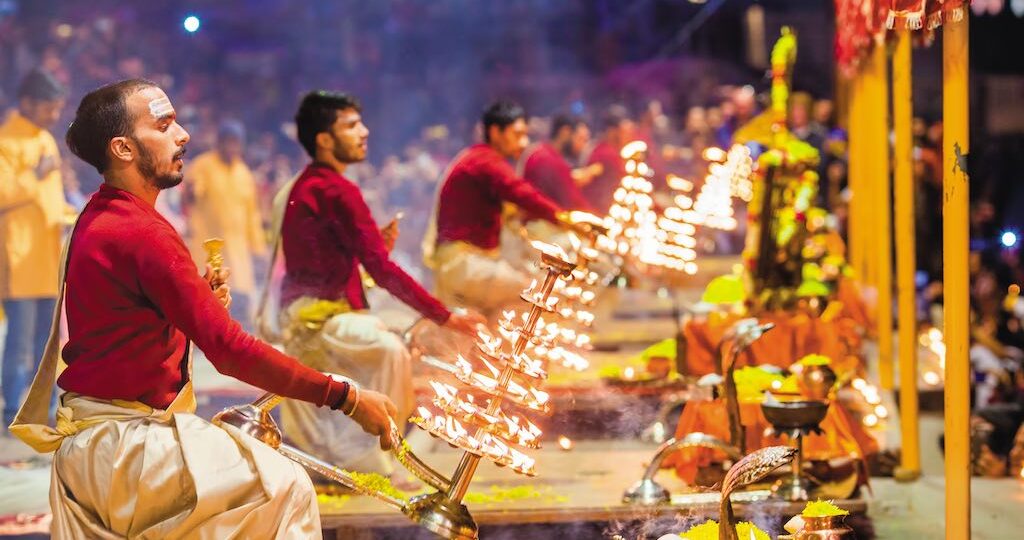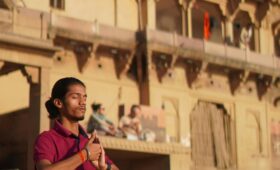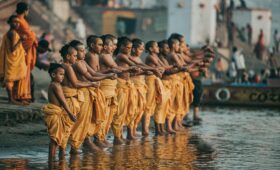Discover the magic of the Ganga Aarti in Varanasi. Explore timings, rituals, best ghats, and why this spiritual ceremony is a must-see experience in India.
Visiting Varanasi without witnessing the Ganga Aarti is like going to Paris and skipping the Eiffel Tower. The Ganga Aarti in Varanasi is more than just a ritual — it is a sensory, spiritual, and cultural event that leaves a lasting impression. In this article, we explore why the Ganga Aarti in Varanasi is a must-see experience, how to plan for it, what to expect, and tips for making it memorable.
—
1. What Is the Ganga Aarti in Varanasi?
2. Spiritual & Cultural Significance
3. Historical Roots of the Ritual
4. When & Where: Timing and Ghats
5. The Experience: What Happens During the Aarti
6. Best Viewing Options & Tips
7. Why It’s Unforgettable — Visitors’ Perspectives
8. Ethical & Practical Considerations
9. Sample Itinerary Featuring the Ganga Aarti
10. FAQs About Ganga Aarti
11. Final Thoughts
—
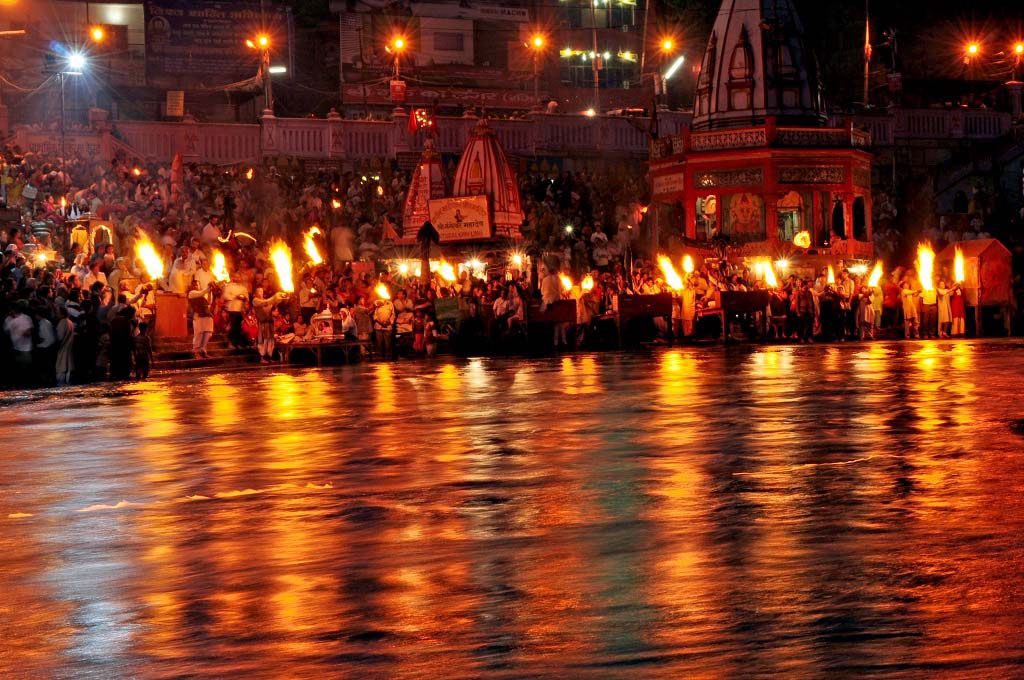
1. What Is the Ganga Aarti in Varanasi?
The Ganga Aarti in Varanasi is a deeply symbolic Hindu ritual performed daily on the ghats (riverfront steps) along the Ganges (Ganga) river. The ceremony is conducted by priests who offer lamps (deepams), incense, flowers, conch shells, bells, and chants to honor Goddess Ganga. As evening sets in, the riverfront transforms into a stage of flame, smoke, and synchronized devotion, making it one of the most powerful spiritual spectacles in India.
—
2. Spiritual & Cultural Significance
# 2.1 The Ganges as Sacred
The river Ganga (Ganges) holds a unique status in Hindu cosmology. It is revered not just as a river but as a living incarnation of the goddess. Bathing in her waters is believed to purify sins, and offering prayers to her is considered deeply auspicious. Thus paying homage through the Ganga Aarti ties into the core of Hindu spiritual beliefs.
# 2.2 Symbolism in the Ritual
* Light (Deepam): The offering of fire symbolizes illumination, purification, and connection with higher consciousness.
* Water (Ganga): Represents grace, fertility, and the flow of life.
* Sound & Chanting: Mantras, bells, and conch shells create a sacred soundscape to evoke devotion.
* Flower offerings: Represent surrender, devotion, and beauty.
# 2.3 Community & Cultural Continuity
The Ganga Aarti is not a static ritual. It is a living heritage that reinforces collective identity, bridges generations, and acts as a cultural anchor for Varanasi’s residents and pilgrims alike. Scholars note that it fosters social cohesiveness, encourages religious devotion, and contributes substantially to regional cultural tourism.
Further, the interaction of tourists and pilgrims in the spectacle creates dynamic “gazes” — how visitors perceive the sacred and how locals present their living ritual as heritage.
—
3. Historical Roots of the Ritual
While no exact date marks the inception of Ganga Aarti at Varanasi, the tradition of honoring the Ganges with fire, chants, and offerings is ancient. Over centuries, local priests (pandits) institutionalized it, and by the 20th century, the organized evening Aarti at ghats like Dashashwamedh became formalized.
The name Dashashwamedh Ghat itself originates from myth: it is believed that Lord Brahma performed ten (dasha) ashvamedha (horse sacrifices) here to welcome Lord Shiva.
Over time Dashashwamedh Ghat has become the flagship site of the evening Ganga Aarti in Varanasi.
In modern times, structural renovations of ghats and better stage planning have elevated the visual quality, while maintaining the authenticity of ritual performance.
—
4. When & Where: Timing and Ghats
# 4.1 Timing & Seasonal Variations
The Ganga Aarti in Varanasi is primarily held in the evening, starting shortly after sunset. The exact timing shifts by season:
* Summer (April – October): Around 7:00 to 7:30 PM as daylight ends.
* Winter (November – March): Earlier, around 6:00 to 6:45 PM
* Duration is typically 30 to 45 minutes.
On festival occasions — such as Dev Deepawali, Kartik Purnima, or Ganga Dussehra — the Aarti is grander, starts earlier, and may extend longer.
# 4.2 Ghats That Host Ganga Aarti
While the most famous is Dashashwamedh Ghat, other ghats also host Aarti ceremonies:
| Ghat | Why It’s Worth Visiting | Distinction & Notes |
| ———————————- | ——————————————————- | ————————————————————————– |
| Dashashwamedh Ghat | The flagship, grandest evening Aarti in Varanasi | Biggest crowd, highly choreographed.
| Assi Ghat | Hosts sunrise / morning Aarti, more tranquil atmosphere | Fewer crowds, spiritual early-morning vibe.
| Rajendra Prasad Ghat | Adjacent to Dashashwamedh, alternative view | Slightly less crowded for evening Aarti.
| Scindia Ghat / Panchganga Ghat | More intimate, lesser-known Aartis | For those desiring a quieter experience.
| Namo Ghat | Newly commissioned (2024) to host Aarti | Offers newer infrastructure and more space.
By choosing the right ghat (and time), you can shape your experience — whether you prefer energetic crowds or reflective solitude.
—
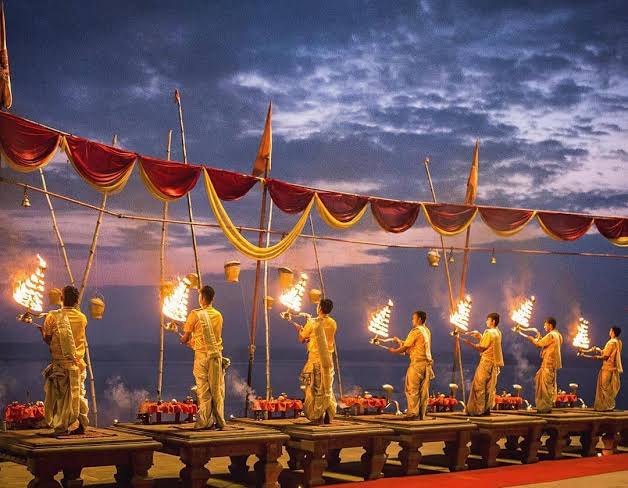
5. The Experience: What Happens During the Aarti
# 5.1 Prelude: Arrival and Settling
* Arrive 30–60 minutes early to secure a good vantage point.
* Vendors sell small diyas, flower garlands, incense sticks. Many visitors buy these to float on the river during or after the ritual.
* The riverbank area fills with devotees, tourists, pilgrims seeking a good views.
* Priests prepare large brass lamps, incense holders, water pots, bells, conch shells, and ritual paraphernalia on raised platforms or steps.
# 5.2 The Opening: Invocation & Sound
* The Aarti begins with the powerful sound of conch shells (shankha) blown in unison to announce the start.
* Bells ring, mantras and Vedic chants rise, and the priests take their places.
* Incense smoke wafts through the riverbank, mingling with twilight and the scent of flowers.
# 5.3 The Core Ritual: Fire, Movement & Synchrony
* Priests begin to wave large brass lamps in synchronized, rhythmic motions — forward, backward, circular — to the cadence of devotional music.
* Multiple tiers of flame may be used (some large lamps with multiple wicks) to intensify the visual drama.
* Flower offerings, water sprinkling, bells and incense accompany the rhythmic fire dance.
* The crowd chants along, waving their own small diyas, joining the energy of devotion.
# 5.4 The Climax: Floating Diyas & Farewell
* At the climax, priests may invite the audience to float their small diyas or leaf platters with flame on the Ganges.
* The river becomes dotted with glowing lights, creating a mirror of flame dancing on water.
* The ritual winds down, prayers conclude, and priests retreat. The riverfront lingers in the afterglow, the smoke and light hanging in air.
Overall, the entire Aarti typically lasts 30–45 minutes.
—
6. Best Viewing Options & Tips
To make the most of your Ganga Aarti experience, consider the following options and practical tips:
# 6.1 Best Spots
* Boat view: Watching the Aarti from a boat on the river gives a panoramic, unobstructed spectacle — the ghats with flame reflections behind you. Many boat operators schedule rides timed with Aarti.
* Rooftop cafes / hotel terraces: Some cafés and hotel rooftops along the ghats offer elevated views, letting you look down onto the spectacle without the crush of crowds.
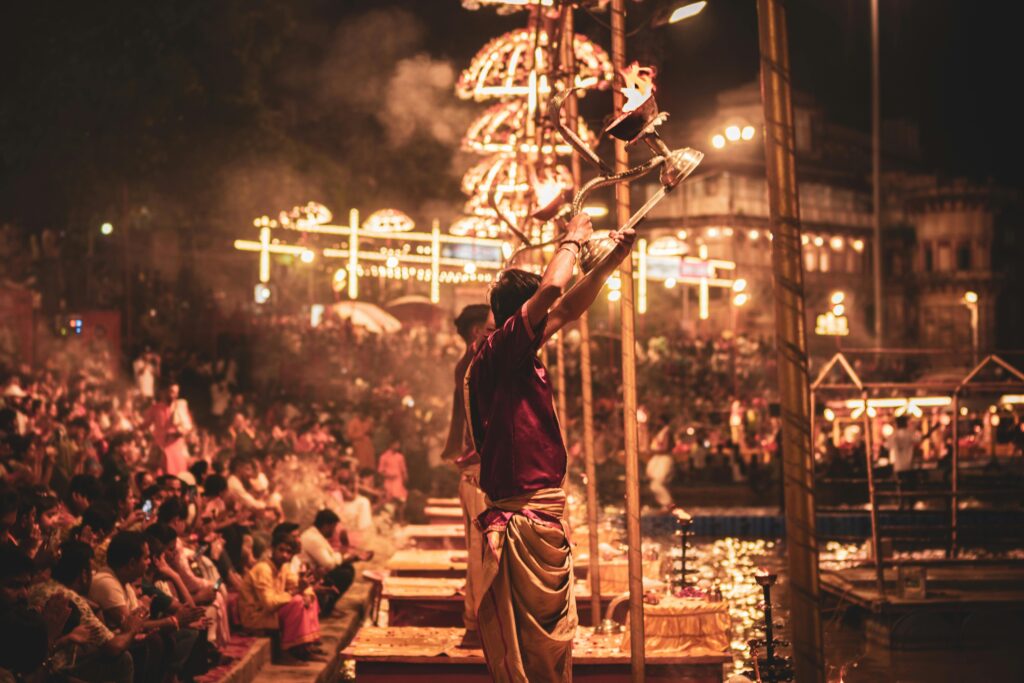
# 6.2 Tips for a Better Experience
1. Arrive early — at least 30–60 minutes ahead to secure good space.
2. Avoid large backpacks or bulky luggage — space is tight.
3. Dress respectfully — modest clothes are preferred (cover shoulders and legs).
4. Carry a flashlight / phone torch — for moving after Aarti in dim light.
5. Use non-flash photography — flash can disturb and ruin the mood.
6. Be careful near the water — the river steps can be slippery.
7. Go with a local guide or travel operator — they can help you navigate, book boat rides, and explain ritual significance.
8. Know the timings beforehand — they may vary slightly with season or local arrangements.
9. Be respectful and quiet — avoid pushing or loud behavior.
10. Consider the morning Aarti — for a quieter, meditative start to the day.
Following these helps you get emotional and spiritual richness rather than jostling and frustration.
—
7. Why It’s Unforgettable — Visitors’ Perspectives
Many travelers say that the Ganga Aarti in Varanasi is the highlight of their India trip. Here are some reasons drawn from visitor reviews and experiences:
* Immersive spiritual energy: The conch shell blasts, rhythmic movements, and scent of incense create a meditative, spine-tingling atmosphere.
* Visual poetry: Flickering flames on water, synchronized lamp movements, and river reflections combine into a living painting.
* Cultural depth: It introduces visitors to Hindu ritual, heritage and devotional life in an experiential way, not just observation.
* Emotional resonance: Many say the first time they watch the Aarti, they feel transformed — moved by beauty, silence, collective devotion.
* Storytelling & memory: The Ganga Aarti becomes a story travelers tell — “I remember the flames dancing over the river…” — a memory that lingers.
One reviewer put it simply:
Another noted:
> “The 45-minute aarti at sunset offers an otherworldly experience… you are never the same after watching it for the first time.”
Hence, for any traveler seeking spiritual, cultural, or emotional depth, the Ganga Aarti is more than sightseeing — it becomes part of your travel story.
—
8. Ethical & Practical Considerations
As with all popular sacred rituals, the Ganga Aarti in Varanasi also raises some ethical and logistical issues. Being aware of them helps you be a more mindful visitor.
# 8.1 Commercialization & Ritual Authenticity
Because it draws many tourists, some elements of Aarti (e.g. commentary, staged effects) may lean toward performance. Some visitors say that after attending once, repeat visits feel more commercial than devotional.
Choosing less crowded ghats or morning Aarti may help preserve authenticity.
# 8.2 Environmental Concerns
* Floating diyas and offerings should use biodegradable materials (leaf platters rather than plastic).
* Excess flower waste and incense residue accumulate on the ghats and river.
* Large crowds generate litter, noise, and pressure on infrastructure.
# 8.3 Crowd Management & Safety
* High foot traffic, tight spaces, and dim light can lead to accidental slips, bumping, or losing belongings.
* When navigating stairs and ghats, move cautiously.
* Avoid venturing too close to the water’s edge, especially if you’re unfamiliar with the terrain.
* For solo travelers, it’s safer to go with a group or during daylight.
# 8.4 Respecting Local Devotees
—
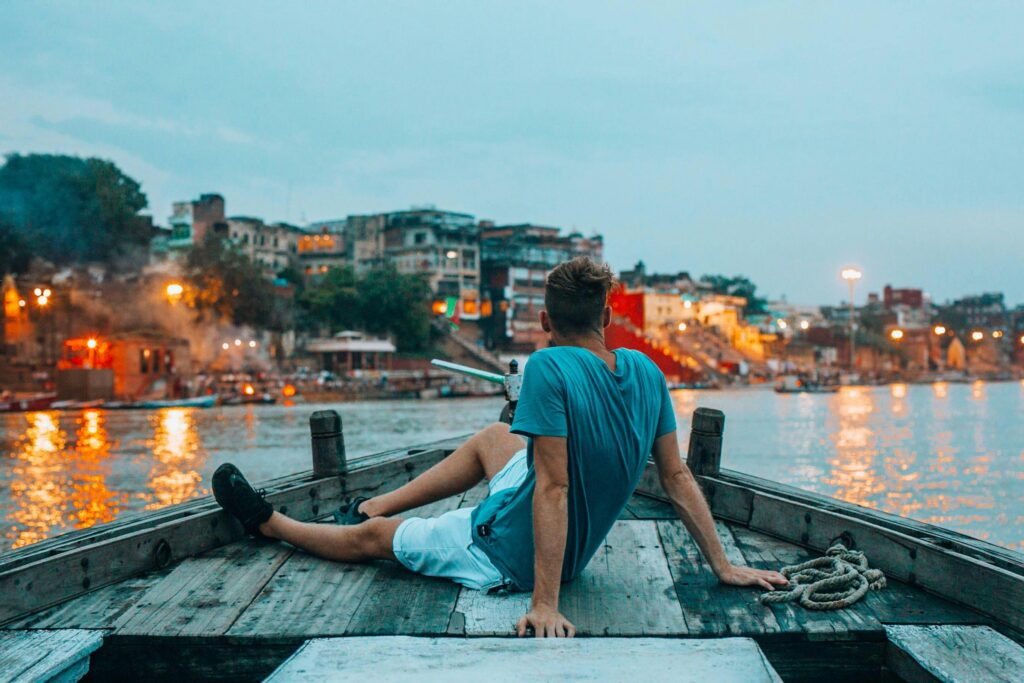
9. Sample Itinerary Featuring the Ganga Aarti
If your travelers want to structure a day (or two) around the Ganga Aarti, here’s a sample plan:
# Day 1: Arrival & Evening Aarti
* Arrive in Varanasi, settle in hotel near the ghats
* Afternoon: stroll the ghats, explore narrow lanes, local shops
* Early evening: refreshments by the riverside
* Arrive at Dashashwamedh Ghat half an hour before Aarti
* Witness the Ganga Aarti
* Post-Aarti: Enjoy riverside walk, dinner with a view
# Day 2: Dawn, Heritage & Reflection
* Wake before sunrise
* Catch the morning Subah-e-Banaras Aarti at Assi Ghat
* Return for breakfast
* Visit Kashi Vishwanath Temple, Sarnath, or ghats by boat
* In the evening, optionally repeat the Aarti from a different vantage point (boat or rooftop)
—
10. FAQs About Ganga Aarti in Varanasi
| Question | Answer |
| ————————————————————– | ——————————————————————————————————————————————— |
| Is there an entry fee? | No, attending the Ganga Aarti is free. However, you may pay for boat rides, VIP seating, or guided services. |
| When should I arrive? | Arrive 30–60 minutes before the scheduled Aarti to find a good spot. |
| Can tourists participate in the ritual? | Tourists may float diyas or offer flowers, but the core ritual is performed by priests. |
| Is the Aarti safe for solo travellers or women travellers? | Yes, generally safe — but remain vigilant in crowds, avoid isolated spots, and travel with companions if possible. |
| Which Aarti is better — morning or evening? | Evening Aarti at Dashashwamedh is grander and more popular. Morning Aarti at Assi Ghat is quieter, meditative, and spiritual. |
| Can I take photos / videos? | Yes, but avoid using flash or obstructing others. Be discreet and respectful. |
| Are boat rides scheduled to catch the Aarti? | Yes, many boat operators offer rides timed for the Aarti so you can watch it from the river . |
| What if ghats are overcrowded? | Use alternate ghats, rooftops, or arrive very early. Send messages via tour operators in advance. |
| Does the Aarti vary during festivals? | Yes — the ritual is more elaborate, extended, and earlier on festival days, with more lights and participants. |
—
11. Final Thoughts
For guests on your Janxii Tours and Travels itineraries, the Ganga Aarti should be a highlight — a memory carved not just in photos, but in the soul.
> ✨ Ready to experience the magic of the Ganga Aarti in Varanasi?
—

